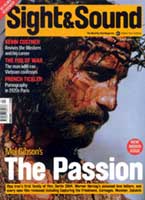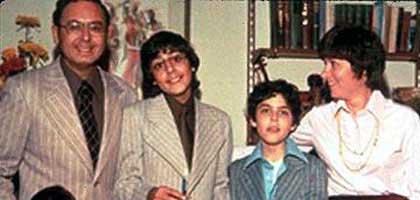
Family Viewing
Film of the Month: Capturing the Friedmans

Capturing the Friedmans mixes three generations of home movies to give a raw portrait of a family riven by charges of child abuse. By Xan Brooks.
Capturing the Friedmans is a portrait of an all-American family in meltdown. It's a study of the porous line between fact and fantasy, of the perilous fragility of a criminal conviction, and of the cultural need to document our lives for posterity. Behind the scenes, it's also the story of how a film about children's entertainers in New York became a film about child abuse on Long Island. Debut director Andrew Jarecki spent eight months trailing David Friedman - New York's premier party clown - before casually asking about his upbringing. Friedman's response is caught on camera: the nervous smile, the panicked eyes, the hesitant delivery. "I have the best memories of my childhood," he begins, then flounders. "Well, there's some things I don't want to talk about."
This movie, in a nutshell, is what David does not want to talk about. In 1984 US customs officials intercepted a package of child pornography bound for his father, computer-studies teacher Arnold Friedman. Over the Thanksgiving holiday Arnold was arrested and charged with multiple counts of abusing the children of his respectable neighbourhood in Great Neck, Long Island. The crisis tore the home apart. Arnold and his youngest son Jesse were eventually convicted and sentenced to lengthy prison terms.
The difficulty, and the fascination, of Capturing the Friedmans is that, on one level, David Friedman does want to talk about it. His initial reticence overcome, he not only proceeds to discuss the events with Jarecki but also allows access to a Pandora's box of old family footage. This ranges from Arnold's Super-8 home movies through to David's camcorder record of the ructions that followed the arrests. During the darkest days before the trial, David even kept a video diary of his innermost thoughts. "If you're not me, you really shouldn't be watching this," his younger self admonishes the camera. "This is private... this is between me now and me in the future." Except that it is not private any longer.
There's a scene in Alek Keshishian's 1991 documentary In Bed with Madonna (aka Truth or Dare ) where the singer's doctor asks her if she would prefer to talk off-camera. Seated nearby, Warren Beatty is wryly amused. "She doesn't want to live off-camera," he quips. "If it's not on camera what's the point of saying anything at all?" In their more humble fashion, the Friedmans are prey to the same obsession. They had made a movie of their lives long before Jarecki put a name to it.
Like any troubled production, this film has shuttled between various directors. In the beginning the auteur was Arnold himself, who shot on Super-8 film and delivered G-rated family entertainment (beach parties, birthday cakes and all). Later the reins passed to eldest son David, who switched to video and a style of raw polemic as the script went awry and the family imploded. Finally Jarecki arrived to cherry-pick the footage and update the tale with talking-head testimonies from the surviving family members (except middle son Seth, who refused to take part), the authorities and the supposed victims (now in their thirties). As such, Capturing the Friedmans views as a compression of three different movies, or perhaps as an overlay of family portraits: the idyll, the nightmare, the subsequent investigation.
If there's a fourth and final version of the film, it's up to the viewer to provide it. Capturing the Friedmans presents a wealth of evidence, but no overt verdict. Arnold and Jesse protested their innocence and several "victims" now claim that the abuse never occurred. The police investigation is called into question, with the father of one boy arguing that the cops "didn't ask him what happened, they told him what happened." Moreover, the film details the witch-hunt mentality that overtook the community, as neighbours out-did each other with tales of multiple molestation in the same way they might boast of SAT scores.
Weighed against this is Arnold's established penchant for child pornography and his eventual, reluctant admission that he had sex with one boy, or possibly two, while on a family vacation. Less tangibly, we have the eccentric behaviour of youngest son Jesse, a limpid Tobey Maguire type who clowns for the camera on the courtroom steps and bounces impishly up to the parents filing in to give evidence against him. From secretive Arnold, through righteous David, fiery Seth and wonky Jesse, the Friedman males are revealed as a close-knit and never entirely trustworthy cabal.
Unfortunately the person best qualified to give an opinion comes trailing credibility issues of her own. One has the sense that Elaine Friedman has spent her life as a kind of semi-detached member of the clan. Pre-crisis, she appears to have been regarded with fond contempt by her husband and sons, who snigger at her sexual naivety and complain that "she has no sense of humour." Later, she is ostracised for not offering Arnold her unwavering support and for 'manipulating' him towards a guilty plea. And yet Elaine sometimes appears as detached from herself as she is from her family. Perhaps she genuinely knows nothing. Perhaps she knows more than she can bring herself to say. "I didn't see it," she claims at one stage. "My eyes were in the right direction, but my brain saw nothing." At another, her dissembling becomes unintentionally comic. Acknowledging Arnold's interest in kiddie porn, she explains that: "He just wanted to look at these pictures and meditate."
Capturing the Friedmans is a compelling documentary, coloured by the influence of Errol Morris in its gallery of oddballs and its teasing lack of judgement. It ends - typically - with a scene that is as flat-out weird as it is moving, as Elaine first opens her hotel-room door to be reconciled with the released Jesse, then shuts it in his face, smirks back at the camera and then opens it again, while her son giggles in the corridor outside. This, effectively, is the last documented footage of the Friedman family. It sits at the top of an archaeological excavation of tormented talking heads, anguished rows and faded Super-8 nostalgia. The deeper you dig, the more questions get uncovered.
There is, incidentally, one further piece of Friedman footage. It's the earliest recorded film of the family, and it lies buried near the centre of Jarecki's documentary. Crackling on a primitive reel, the footage shows Arnold's sister, who died of blood poisoning in her infancy. This film was shot long before Arnold picked up his camera, at a time when he was a child himself. Preserved for future generations, his sister dances in a bleached-out, ghostly slow-motion - a remnant from a happier Friedman family, before the rot set in.
